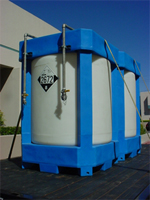UltraCat Catalytic Filter System For DeNOx / Selective Catalytic Reduction
Selective Catalytic Reduction (SCR) is the process of NOx reduction, or DeNOx, that occurs when a NOx source is mixed with ammonia and allowed to react at the surface of a catalyst.
The liquid ammonia injected upstream turns into gas, mixes with the NOx gas, and the mixture reacts at the catalyst. The result is conversion to nitrogen gas N2 and water vapor H2O, both harmless constituents of the atmosphere. While the process uses aqueous ammonia, there is no wet residue or by-product. All the reactants leave the system as gases.
Tri-Mer offers three DeNOx approaches:
- Dry removal with the unique catalytic ceramic catalyst filters for gas temperatures greater than 350°F. This technology features DeNOx at temperatures lower than conventional SCR while also capturing particulate, and offers the option of removing acid gases, mercury, and dioxins. See our NOx Control page for details.
![]()
Aqueous ammonia used on smaller DeNOx projects. - Conventional stand-alone SCR equipment. Tri-Mer offers low temperature DeNOx that operates at roughly 300°F to 750°F. For more information, see our Low Temperature SCR page. We also offer high temperature DeNOx that operates in the range of 600°F to 1100°F.
- A non-SCR process, wet scrubbing with the Tri-NOx MultiChem system, for applications under 350°F with special requirements. See Tri-NOx for details.
DeNOx efficiencies over 90% can be achieved. Tri-Mer integrated SCR systems, whether filter based or stand-along catalytic reactor, include ammonia injection and storage tanks. For smaller applications, 300 gallon totes of aqueous ammonia are suitable.
Read a full overview of the UltraCat Catalytic Filter system.

